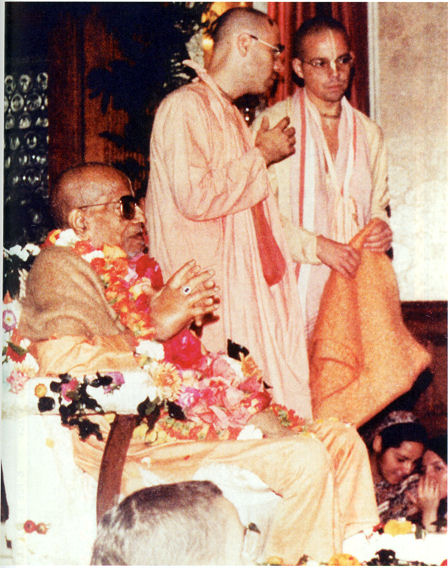
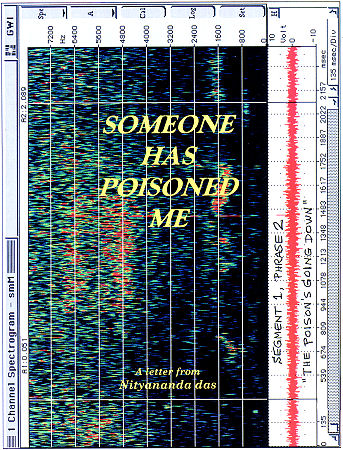
Download complete book as HTML ZIP-File
Download the E-Book: Someone has poisoned me
Someone Has Poisoned Me - BY: NITYANANDA DAS


Download complete book as HTML ZIP-File
Download the E-Book: Someone has poisoned me
The Facts About Srila Prabhupada's Poisoning by Arsenic
"So as Krishna was attempted to be killed... And Lord Jesus Christ was killed.
So they may kill me also." (Srila Prabhupada, May 3, l976, Honolulu)
"my only request is , that at the last stage don't torture me, and put me to death"
(from SPC Vol. 36, November 3, 1977 tape recorded Room Conversation)
[PLEASE NOTE: ADDRESSES, EMAILS, PHONE NUMBERS ETC. MIGHT NO LONGER BE CORRECT!]
1416-A Vassar, NE
Albuquerque, NM 87106
(505)-268-0496
INVOICE
January 26, 1998
Randy I. Stein
re: Srila Prabhupadi Investigation
Materials:
Other
subtotal: $4,458.95
Retainer paid: -$150.00
Total Due: $4,308.95
Please make checks payable to CAE (or: John J. Mitchell D/B/A/ CAE)
Computer Audio Engineering
1416-A Vassar, NE
Albuquerque, NM 87106
(505)-268-0496
Jan. 25, '98
Procedure Report
re: Srila Prabhupadi Investigation
Audio cassette
Randy I. Stein
NOTE: This recording is reported to be a first generation copy of the original archive recording. It is reported to have been made by the archive personnel.
Note: Two different recordings were made. One for the purpose of enhancement, the second for the purpose of signal analysis. There were five predefined sections that were to be given special attention.
Recording for the purpose of enhancement:
The entire Side A was recorded into the digital system with preliminary enhancement Only the predefined segment from Side B was recorded:
a. Transfer from HK CD491 to Pro Tools III v4.01 digital system (-18db calibration) via Mackie 3204 analog mixer.
Recording for the purpose of signal analysis:
NOTE 1: The signal analysis and dialog decoding findings of each segment is reported in a separate report for each. A spectrogram print of each segment is included. All of Segment 1, and Segment 4 part 1 are Tektronix Phaser 550 600 dpi color prints. The remainder are Hewlett Packard LaserJet 4mv 600 dpi black and white prints. All originals are in color and a pict file of each has been preserved and may be accessed from zip disk. The F-T-A displays are included with each report as supporting visual documentation for those who have the ability to read them. The sound files for each segment are preserved and can be easily loaded into a spectrographic system.
NOTE 2: During signal analysis and dialog decoding, 9 hours of consultation was done with Dr. Helen McCaffrey, Department of Communication Sciences and Disorders, Texas Christian University.
4. Enhancement
a. All processing is in the digital domain. Specific software settings are preserved as session files and, if needed, may be accessed from zip disk for specific information. Five segments were predefined as requiring special attention, four from Side A and one from Side B of the cassette. Those from the full recording of Side A in the digital system were identified and extracted digitally from the full file for addition processing.
b. Each segment was processed using various combinations of:
c. Audio files were subjected to various combinations of the above for noise reduction, frequency bandlimiting, frequency equalization, deconvolution filtering, sidechain and wideband compression, binaural simulation, processing delay compensation, and overall signal amplitude increase/limiting. IDR dither added for increased bit resolution and noise reduction. It should be noted that the sections containing whispers have been subjected to anywhere from 50 to 70 db increase - it is unlikely these sections could have previously been clearly heard (or even perceived) on the average consumer playback system.
d. Fader automation set for amplitude equalization.
5. Output Transfer
a Direct digital transfer from Pro Tools III to DA-30/digital cassette.
b. Analog transfer from Pro Tools III to HK CD491/analog cassette. Dolby noise reduction was not implemented.
Note: Digital audio has a much higher degree of clarity than analog cassette. The analog cassette will have a 15-20% loss of detail, this is the nature of the technology. The digital version should be for playback whenever possible.
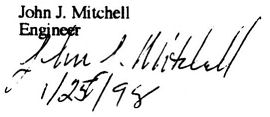
Computer Audio Engineering
1416-A Vassar, NE
Albuquerque, NM 87106
(505)-268-0496
Jan. 25, '98
Segment 1 Report
re: Srila Prabhupada Investigation
Segment 1
Randy I. Stein
Nov 10, 1977
Tape T-46
Side A
± 02:00 minutes
Push real hard, it's going down [him/'im|. The poison's going down
Voice phrase 1: Push real hard, it's going down [him/'im|
Voice phrase 2: The poison's going down.
Analysis Summary
The manner of production is that of a whisper, which causes a somewhat distorted production and loss of signal information.
Voice phrase 1 :
Push
The exact point of the /p/ onset cannot be determined. However, there is some evidence of /p/ energy at approximately 0.1269ms. /u/ energy cannot be determined. /sh/ energy is clearly defined in an F-T-A display between 0.28316ms and 0.38036ms, with broadband energy from 2.4 Khz extending to 6.5 Khz, which is consistent with the production of /sh/.
real
F-T-A display shows formant energy is present from 0.39727ms to approximately 0.63394 between 425 Hz and 1.4 Khz. LPC based formant analysis across the utterance shows tongue trajectory across the syllable consistent with /real/.
hard
At 0.69311ms there is a broadband energy burst from approximately 800 Hz to 1.6 Khz which is consistent with /h/ frication. There is some evidence of /d/ at 0.85793, though it is soft in production and the aural evaluation is probably more revealing.
it's
/i/ is believed to be between 0.87061ms and 0.95936, but the spectrogram reveals no useful information. However, /t's/ is clearly evident from .095936 to 0.99740, with broadband frequency between 1.2 Khz and 4.8 Khz which is consistent with the whispered production of /t's/.
going
/g/ is indicated at 1.03966 by a slight energy spike at 200 Hz. /oing/ cannot be determined.
down
/d/ is clearly evident at 1.42002ms with a short duration energy spike from 150 Hz extending to 6.175 Khz. The following /ow/ was subjected LPC analysis and shows a definite downward motion indicating the rounding of the lips, which is consistent with /ow/. /n/ is of very short duration and no information could be extracted.
An amplitude envelope cannot confirm the number of syllables in this phrase due to the speaking amplitude and noise amplitude being close. However, the amplitude envelope does reveal corresponding amplitude
peaks with /sh/, /t's/ and /d/.
Voice phrase 2:
The
Beginning at 0.13058ms and extending to approximately 0.32013ms a broadband energy burst is evident between 4.8 Khz and 6.8 Khz which is consistent with /th/ frication. /e/ is evident at 0.32434 by sudden energy at approximately 250 Hz.
poison's
/p/cannot be exactly isolated. Segmenting causes an onset burst which could be construed as a /p/, however, it is believed to be about 0.42965ms. /oi/ was isolated in the F-T-A display between 0.44649ms and 0.76241ms. The clear upward movement of F2 from /o/ to /i/ is typical of a diphthong and is consistent with /d/, as is the frequency movement from approximately 800 Hz to 1.6Khz.
NOTE: The reviewer should note the similarity between this /oi/ and that of Segment 4 phrase 1.
NOTE: It should be noted that the enhanced recording presents this segment as several different time expanded segments. As each version presents a mere expanded segment, the /poi/ sound should become more evident to the listener.
/s/ and /'s/ is very apparent in the F-T-A display between 0.90141ms and 1.58379ms in the broadband frequency range of 4.2 Khz to 6.8 Khz, Which is consistent with the production of /s/. In this case there are two distinct frequency bands that extend over the remaining words. This is a known feature of co- articulation/transition speech production and is consistent with this phrase.
/on/ could not be isolated and measured.
NOTE: All features isolated and evaluated are consistent with /poison's/. Analysis data combined with aural perception indicate it is more likely /poison's/ than any other English word.
going
/g/ is believed to be at approximately 1.16678ms. /oi/ is from 1.20048ms to 1.33106ms. Again, there is clear upward movement of F2 from /o/ to /i/, which is typical of a diphthong and is consistent with /oi/, as is the frequency movement from approximately 800 Hz to 1.6Khz.
NOTE: One should note the similarity of /oi/ in /poison's/ and the /oi/ in /going/ in this speakers voice.
/ng/ cannot be clearly measured.
down
/d/ produces a clear plosive amplitude spike at 1,44057ms, with a frequency range of between approximately 200 Hz and 6.6 Khz. The following tow/ was subjected LPC analysis and shows a definite downward motion indicating the rounding of the lips, which is consistent with /ow/. /n/ is of very short duration and no information could be extracted.
NOTE: one should note the similarity of /down/ in phrase 2 with /down/ in the preceding phrase 1.
Following this utterance is an inhale at 2.06819 in the frequency range of 1.6 Khz.
An amplitude envelope cannot confirm the number of syllables in this phrase due to the speaking amplitude and noise amplitude being close. However, the amplitude envelope does reveal a corresponding amplitude
peak with /d/.
Conclusion
All available data is consistent with their points of correspondence of the whisper production of the two phrases "Push real hard, it's going down /him/'im]. The poison's going down." Some areas of production cannot be confirmed.

AUTHOR'S NOTE: The full color spectrogram of the whispered phrase "PUSH REAL HARD, IT'S GOING DOWN (HIM)" is found in color on the rear outside cover on this book. It is titled for identification, Segment 1, Phrase 1. The full color spectrogram of Segment 1, phrase 2, namely, the whisper "THE POISON'S GOING DOWN," is found in color on the front outside cover of this book.
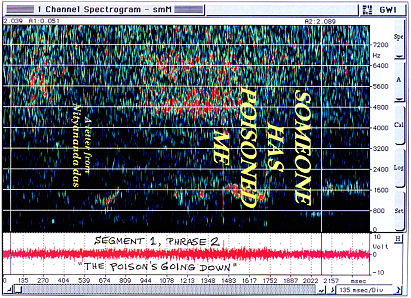
Audio Spectrographic Analysis: THE POISON'S GOING DOWN
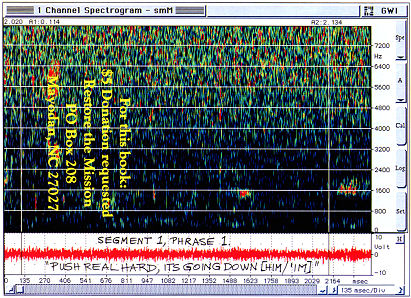
Audio Spectrographic Analysis: PUSH REAL HARD, IT'S GOING DOWN (HIM)
Computer Audio Engineering
1416-A Vassar, NE
Albuquerque, NM 87106
(505)268-0496
Jan. 25, '98
Segment 4 Report
re: Srila Prabhupadi Investigation
Segment 4
Randy I. Stein
Tape T-46
Side B
35:14 minutes ±
Poisoning for a long time.
Part 1
Voice 1: {Hindi/Bengali}
Voice 1: Poisoning for a long lime.
Srila Prabhupada: To me?
Unknown voice: [That's really] original. Voice 1: Get ready to go.
Part 2
Voice 1: My number's in the [passport/passbook]
Unknown soft voice: Ok
- this may be an audio illusion caused by background noise, and not a human utterance.
Voice: Going now, [dahm-bu/pahm-bu/bahm-bu]
Soft elder voice: [Yes, today/yesterday]
Voice: Anything might of happened today.
Voice: [Look], I'm not afraid to die.
Soft elder voice: That's good
Analysis Summary
Part I
The manner of production is that of normal voice, but is somewhat distant.
Voice 1: {Hindi/Bengali} - this was not analyzed.
Voice 1: poisoning
This word is reasonably clear on the enhanced audio tape. /p/ shows clearly in an F-T-A display at 0.02382ms with a characteristic short duration amplitude spike ranging from 100 Hz to 5.1 Khz. The following /oi/ is of particular interest in that it shows the same characteristics as those in Segment 1 phrase 2. The reviewer should note these similarities. The /oi/ area of production is displayed in the F-T-A from 0.08576ms to 0.24060ms. The structure of /oi/ is characteristic with a clear upward movement of F2 from /o/ to /i/ (typical of a diphthong, and consistent with /oi/), as is the frequency movement from approximately 800 Hz to 2 Khz. In this case the upper frequency is somewhat higher than in Segment 1 phrase 2, however this is easily reconciled by the speaking manner being that of normal production rather than a whisper, different tonal inflection, and perhaps being a different speaker.
This recording displays a constant noise energy band between approximately 5.4 Khz and 6.8 Khz. This obscures characteristic frequencies associated with /s/production. However at the point where the /s/ is heard - 0.25013ms to 0.32160ms, there is a characteristic drop in low frequency energy, which is consistent with /s/ production.
The manner of production is that of "conversational", poi-z-ning. The /o/ can neither be heard nor found in signal analysis.
/ni/, between 0.33113ms and 0.52400ms, shows characteristic F2 frequencies between 1.8 Khz and 2.2 Khz. /ng/ is very brief, which is "conversational", and cannot be measured.
NOTE: It should be noted that there is an uncharacteristic accent on the second syllabic of this word. This may indicate the speaker has a first language other than English, or is fluent in another language and from time to time mixes dialect prosody.
NOTE: All features isolated and evaluated are consistent with /poisoning/. Analysis data combined with aural perception indicate it is more likely /poisoning/ than any other English word.
for a
This is pronounced "fora", again a "conversational" mannerism. /f/, from 0.52647ms to 0.57412ms, has produced a long term broadband frequency energy burst between approximately 2.4 Khz and 5 Khz. This is consistent with /f/ frication. /ora/,0.63129ms and 0.75993ms, is spoken very quickly and it has not been possible to separate the components, although there is energy consistent with vowel energy.
long
This area, between 0.76231ms and 0.96004ms, is mixed with a background impact signal. Thus much of the signal may be considered unreliable regarding analysis. However, from approximately 0.8933ms to 0.96004ms, there is a sudden stop of what may be FI and F2 energy, but a continuation of lower frequency energy between approximately 100 Hz and 300 Hz which may be an indicator of /ng/ nasalization energy.
time
This area is from 0.96004ms to 1.33881ms. Production is not that of precise articulation and exact component isolation is impossible. However, at 1,08868ms there is a low frequency broadband signature from approximately 100 Hz to 300 Hz which may indicate /m/ nasalization. In the range of 4 Khz to 5.6 Khz there is a broadband energy signature, usually associated with frication and the sibilant /s/ . However, in this case there is not the expected low frequency energy drop associated with /s/ production, rather there is an intensification associated with /m/ nasalization, thus this may indicate co-articulation of /im/ for the word /time/. The exact cause of this has not been determined.
An amplitude envelope confirms the number of syllables consistent with "Poisoning for a long time".
NOTE: During consultation with Dr. Helen McCaffrey regarding this phrase, she was not able to perceive /long/, rather hearing the phrase as being /poisoning for a time/. However, she does confirm that an amplitude envelope confirms the phrase syllable content as being consistent with /poisoning for a long time/.
Srila Prabhupada: to me
Entrance is at 0.3628. This phrase is consistent with regard to frequency content and apparent lip rounding of an elder male speaker, /m/ shows broadband low frequency energy consistent with /m/, as well as diminished high frequency from /ml nasal resonance consistent with the production of /e/ in combination with /m/, as in /me/.
It is interesting to note that there is a voice pitch break which is consistent with the known age of the speaker and the Hindi language.
The enhanced audio tape is clear with regard to this utterance.
Unknown Voice: [That's really] original
This phrase was previously not perceived till recording enhancement was undertaken. There is considerable background noise in this signal, which makes it impossible to properly analyze the phrase. There does appear to be the possibility of /th/ and /s/ frication at the appropriate points, but there is also a broadband noise signature from approximately 5.2 Khz to 6.8 Khz which obscures needed information. No conclusion can be made from signal analysis, so the ear will need to be the guide for this phrase.
Voice 1: Get ready to go
The same noise problem is in this phrase as with the previous. In addition, there is a high impuc background noise that comes at the entrance of the phrase. This signal is corrupted and data obtained fn analysis would be unreliable. However, the phrase seems to be easily understood on the enhanced audii tape and the ear should be the guide.
Part 2
NOTE: Part 2 is problematic in that the signal amplitude is so low that there is a high level of signal/noise mix, and very little data that can be extracted with reliability. The ear should be the guide regarding part 2.
Voice 1: My number's in the [passport!passbook]
/my/ displays a characteristic F2 late start; being a reduction of high frequencies in the first few milliseconds of lyl. This is consistent with Iml nasal resonance. LPC analysis identifying F2 trajectory confirms a frequency range consistent with lyl, as in /my/.
/number's in the/ shows nearly nothing in an F-T-A display. There is the possibility of /s/ and /i frication at 0.50364ms and 0.75710ms, but it is slight information and may be part of the surrounding noise.
[passport/passbook| - there are two clear background high impact signatures at 0.89665ms and 1.33316ms which obscures information regarding this utterance. However, there is clear Is! frication a 1.04678ms in the frequency range of 4. Khz to 5.2 Khz, however the noise signature band from 5.4 K to 6.8 Khz obscures any other indication of Isl.
Unknown soft voice:Ok
This cannot be isolated and analyzed. This may not be a human utterance, rather it may be an audio illusion created by background noise.
Voice X:Going now, [dahm-bu/pahm-bu/bahm-bu]
There is no useful information that could be extract regarding this phrase.
Soft elder voice:[Yes, today/yesterdayl
/s/ can be confirmed at 0.36616 to 0.46626 with a broadband frequency burst from approximately 3.2 Khz extending into the obscuring noise band. No other information can be obtained regarding this signal.
Voice X: Anything might of happened today.
No information can be extracted regarding this signal.
Soft elder voice: That's good
What appears to be /s/ frication and the /g/ entrance can be confirmed at 0.51934ms and 0.72805ms. No other information can be obtained for this signal.
Conclusion
All data in part I of this segment is consistent with the above stated dialog. Very little of part 2 can be confirmed.

AUTHOR'S NOTE: The full color spectrogram for the whispered phrase by Jayapataka Swami "POISONING FOR A LONG TIME” is included as the second page of the color inserts in this book, titled Segment 4, Part la. Srila Prabhupada's response "TO ME?" is represented by a color spectrogram on the third page of the color inserts, marked Segment 4, Part lb. The subsequent words by an unknown speaker and Jayapataka Swami, "(THAT'S REALLY) ORIGINAL. GET READY TO GO," is represented as the fourth page of color inserts in a spectrogram marked Segment 4, Part lc.
![Audio Spectrum Analysis: My number's in the [passport!passbook] Audio Spectrum Analysis: My number's in the [passport!passbook]](audio-forensic/segment4_s.jpg)
Audio Spectrographic Analysis: My number's in the [passport!passbook]
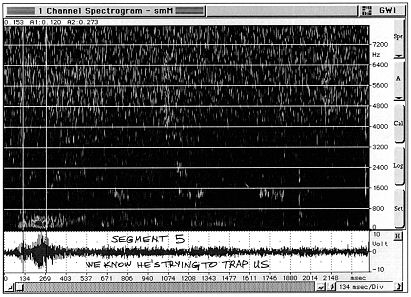
Audio Spectrographic Analysis: We know He's trying to Trap us
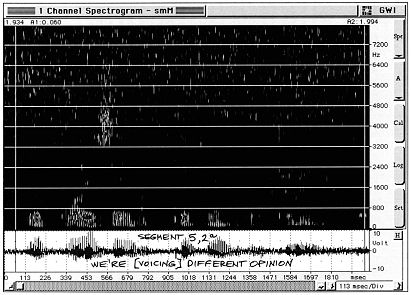
Audio Spectrographic Analysis: We're (voicing) different opinion
Summary Report
Received 4.13.98
Acoustic Analysis of Speech
Helen A. McCaffrey, Ph.D., CCC/A
3913 W. 4th St.,
Fort Worth, TX 76107
This document certifies that I am in agreement with the findings of acoustic analyses submitted by Jack Mitchell, Computer Audio Engineering that were completed with my consultation. Recorded signals were digitized and prepared for analysis by Jack Mitchell. Digitized signals were forwarded to this consultant via e-mail. The consultation was conducted over the telephone while Mr. Mitchell and this consultant simultaneously viewed the signals under consideration each using SoundScope speech analysis software, thus permitting each individual to view the same information throughout the consultation. Mr. Mitchell’s report is a record of the findings and conclusions from that analysis session. I am in agreement with the content of that report.
This consultant first listened to the digitized signal and identified the possible phrase or word being said. Mr. Mitchell then supplied his interpretation. In the case of disagreement in perception, signals were replayed until a consensus could be reached. Following perceptual analysis, computerized acoustic analysis was conducted. The absolute frequencies and intensities of speech sounds (vowels and consonants) vary with speaker and with consonant/vowel context. Consequently, acoustic speech analysis does not yield absolute identification of speech sounds. Instead, an analysis reveals the most likely categories of sounds (e.g. made with the lips, produced with signal stopping as in /d/ or noisy signal frication as in /s/). Thus, acoustic analysis may confirm a message that has been perceived via listening to a signal and may also yield alternatives that can be further specified by attending to which word/sound choice is the most logical in the context of the probable message.
To that end, the acoustic analysis was conducted to confirm or disconfirm the perceptions of the listeners. Four analysis approaches were employed. The first and primary procedure was spectrographic analysis which is a three dimensional visual display of the digitized signal along the parameters of time, frequency, and amplitude and will be referred to as an F-T-A display for consistency with Mr. Mitchell’s designation. FFT and LPC analyses provided spectral (amplitude by frequency) information and were used to identify frequency peaks in the signal at particular instances in time. An amplitude envelope of the utterance was obtained to identify amplitude peaks that are consistent with syllable production (for example, 2 peaks appear in the envelope for two-syllable words or for two one-syllable words).

Helen A. McCaffrey, Ph.D., CCC/A
Audiologist
Computer Audio Engineering
1416-A Vassar, NE
Albuquerque, NM 87106
(505)268-0496
Addendum
re: Srila Prabhupada Investigation
Report of January 25, 1998
Nico Kuyt
Carolina's Vedic Village Society
March 26, 1998
Since having completed the first part of this investigation, CAE has been provided with dill'ercnt recordings of the audio tapes in question, as reported in report dated January 25, 1998. These new copies where provided by Paul Tombleson of the Bhaktivedanta Archives. The recordings are analog to digital transfers. The following information regarding the transfer procedure has been provided by Mr. Tombleson:
— beginning of e-mail
Received: from cronus.host4u.net (root@cronus.host4u.net |209.150.128.18])
by kitsunc.swcp.com (8.8.7/1.2.3) with ESMTP id MAA09522
for <cae@swcp.com>; Fri, 27 Feb 1998 12:30:39 -0700 (MST)
Received: from 207.205.131.185 (Pool-207-205-131-185.aUn.gnd.net [207.205.131.185])
by cronus.host4u.net (8.8 5/8.8.5) with ESMTP id NAA08315
for <cae@swcp.com>; Fri, 27 Feb 1998 13:27:17 -0600
Message-ID: <34F70674.867422BC@xcnacom.net>
Date: Fri, 27 Feb 1998 14:31:18 -0400
From: Paul Tombleson <paul@xenacom.net>
Reply-To: paul@xenacom.net X-Mailen Mozilla 4.01 (Macintosh; I; PPC)
MIME-Version: 1.0
To: CAE Studio Jack Mitchell <cae@swcp.com>
Subject: Ready X-Pnonty: 3 (Normal)
Content-Type: text/plain; charsct=us-ascii; x-mac-typc="54455854"; x-mac-crcator="4D4F5353"
Content-Transfer-Encoding: 7bit
X-UIDL: 42d7228f3893f698c6b09b5f31 a0ec26
Dear Jack,
The 4 DAT's will be shipped to you on Monday (overnight UPS). Please keep an eye out on Tuesday.
Regards Paul Tombleson
Friday, February 27, 1998
Procedures followed for transfer to DAT from original cassette tapes.
Original cassette tape 770528 and 771110 were played back on a Nakamichi CR-7A. These original tapes were played from the beginning of the tape including all of the leader tape. The rccoidings proceed until the very end of the original cassette tape including all of the end leaders. This was repeated for all four sides of the two original cassette tapes in question.
The recording DAT deck is a Sony PCM 2800. The recording was carried out as follows. The DAT deck was put in record and allowed to start. Alter approximately 5 seconds the Nakamichi CR-7A was started. When the recording's end (until the Nakamichi CR-7A came to a complete stop and disengages the head) approximately five seconds after that the Sony DAT PCM 2800 was stopped (tape 771110 side A is approximately 25 seconds before DAT stopped).
— end of e-mail —
The above stated procedure is exactly as requested by CAE. It should be noted that these recordings where also recorded at the sample rate of 48Khz, which is the professional rate, rather the consumer rate of 44.1 Khz. It should also be noted that these recordings, for the purpose of enhancement and speech decoding are most likely as good as having the original. The clarity on these digital copies exceeds the previously provided analog copies by magnitudes.
Once receiving the digital copies, all segments analyzed as reported in the report dated January 25, 1998 were checked for accuracy. The findings as previously reported arc solidly confirmed by this new analysis, with the following exceptions, additions and comments:
Segment 2:
The final word was in question, however the digital recording is much more detailed and presents a more clear aural impression of /trick/. Thus, I am now strongly leaning toward the word /trick/. Also, regarding [class/glass], there is a more apparent voice onset time between the first consonant and /l/ This is more characteristic of /cl/ than /gl/, thus creating a strong leaning toward the word /class/.
Segment 4 part 2:
The final phrase was thought to be /that's good/. The digital recording has revealed this to be /very
good/.
Segment 4 part 2 addition:
The digital recording has revealed that this section continues. After what is now /very good/, the following can be heard:
Voice X: You're taking it right now.
Soft elder voice: How's this? — Let it go.
All other segments remain as reported in the January 25,1998 report.
Due to the fine aural quality of the digital recordings additional possible pertinent information has been obtained. This is as follows (with recording location indicated):
The following is from Side A of the Nov. 10, 1977 recording:
Whisper - 0:57.692 - Going down.
Whisper - 3:25.485 - Did it hurt?
Whisper - 21:40 — He's gonna die.
Whisper - 21:58.641 - Listen, he's saying ... going to die.
Whisper - 46:51.445 - Yes, a heart attack time.
The following is from Side B of the Nov. 10, 1977 recording:
Lower under-tone voice - 21:25.878 -I told you what's going on. Ordered to [2 unintelligible syllables]. He's as [sly/slay] as they [come/go].
Note: [sly/slay] - this sounds like a combination of /ei/ and /v/. Most likely this is the speakers dialect for the word /sly/.
Considerable additional information has been obtained from the digital copies of these recordings. This information will be covered in a forthcoming report.
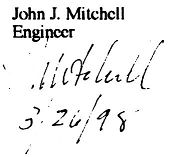
Srila Prabhupada left this mortal world on November 14, 1977.
But He lives forever in His instructions, and His followers will always live with Him.
"He reasons ill who tells that Vaishnavas die
While thou art living still in sound!
The Vaishnavas die to live, and living try
To spread the Holy Name around"
(Śrīla Bhaktivinoda Thākura)
HARE KṚṢṆA HARE KṚṢṆA KṚṢṆA KṚṢṆA HARE HARE
HARE RĀMA HARE RĀMA RĀMA RĀMA HARE HARE